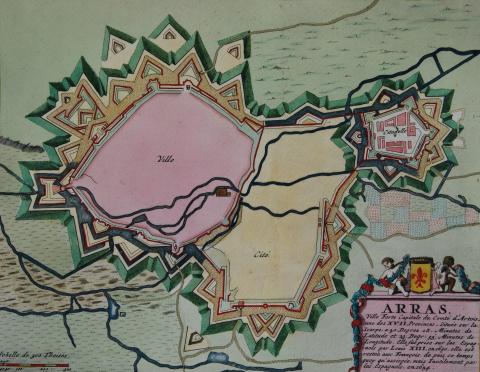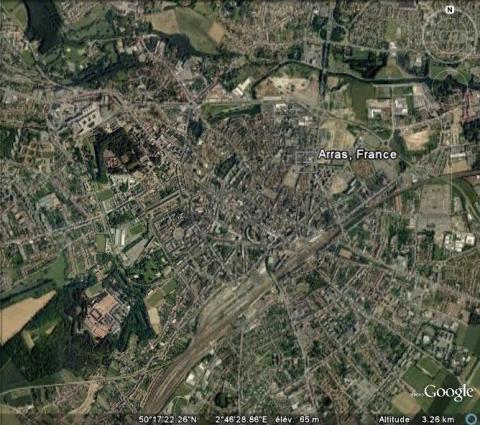Arras
History and description
A town of Gallo-Roman origin, situated where the Scarpe and the Crinchon stream meet, Arras was endowed with a double urban wall at the end of the middle Ages. The first structure dates from the 12th century and enclosed the town as such. The second housed a new district called the Quartier Abbatial, and dates back to the 14th century. These two urban walls were modified in the 16th-17th centuries, under the Spanish, by the addition of advanced work. On 13 June, 1640, France besieged Arras, which later fell on 9 August. After an abortive attempt by the Spanish to retake the town in 1654, an Italian engineer named de Vallé started restoring the walls in 1655 but did no more than demolish the external parts.It was not until 1668 that genuine restoration took place: Vauban was responsible for the project of the current citadel, which was the blueprint for the engineer d’Aspremont to apply and direct in person. The construction was complete in 1670. The citadel that resulted was in the form of a square, positioned within a fortified pentagon, surrounded by moats and defensive water features created by diverting the Crinchon stream. The entrance was via the porte Royale, on the side of the town, complete with two harrows and a guardroom in the plan, all of which decorated with a triumphal arch dedicated to Louis XIV. The rectangular central courtyard was surrounded by brick buildings housing troops with pilasters and chalk shingle; a chapel dedicated to Saint-Louis, with a Corinthian facade and channelled columns, dating from 1673 and an arsenal from 1678, made of the same materials as the barracks. The ravelins and counterguards were added in 1709-1710, in line with Vauban’s projects. The final work carried out dates back to the last century: a fourth barracks was constructed using the same materials as its predecessors in 1994, to thus close off the rectangular courtyard. Hangars and garages were added to the east.
As for the urban wall, it was recast from 1671. New flanks, ravelins and redoubts were constructed. The covered road was relaid and countermines were drilled into the redoubts and under the ramparts, extending up to fifty metres from the glacis, to protect the south side of the urban wall, which could not be defended against flooding.
Current state
The citadel still stands today. Occupied by the army up until 2009, it was bequeathed to the town of Arras. In the interests of preservation, a renovation project is currently being devised. Visits are possible to this citadel, which is included on the World Heritage List as part of the fortifications of Vauban, when accompanied with a guide. The ramparts have been transformed into a municipal park, exploiting the greenery in which they are covered. Another reason for preserving them is also to preserve memories: one of the moats was a place of execution during the Second World War. On the other hand, the city fortifications were demolished in the period 1891 to 1896, with nothing remaining except a fortification in a park, to the north-west of the town and to the north of the citadel. The routes in question may no longer be marked, but can be seen on a relief map of the town, which is kept at the municipal musée des Beaux Arts (Fine Arts museum).
Arras
Arras
50° 17' 23" N, 2° 46' 51" E
Type
citadel and urban wall
Engineers
Sébastien le Prestre de Vauban, Vicomte d’Aspremont
Department
Pas-de-Calais
Region
Hauts-de-France
Bibliography
- BELLART (G.), MAISON (F.), Les fortifications d’Arras du XIIe au XIXe siècle, étude des œuvres et documents présentés en 1976 à l’exposition « Arras ville forte », Arras, 1976.
- BERNARD (H.), Arras : ville fortifiée, Arras, 1993.
- BRAGARD (P.), CHEUVA (P.), COMBEAU (Y.), (et alii), Etoiles de pierre. Voyage en Nord Pas-de-Calais, Villeneuve d’Ascq, 2003.
- DUMONT (R.), La Citadelle d’Arras, Arras, 2013.
- HANSCOTTE (F.), FAUCHERRE (N.), La routes des villes fortes en Nord, Paris, 2005.
- MONGIN (M.), STEENBERGEN (M.), La citadelle d’Arras, Place forte du « pré carré », Woippy, 2015.
- SALAMAGNE (A.), Vauban en Flandre et en Artois : les places de l’intérieur, Saint-Léger-Vauban, 1995.
- SALAMAGNE (A.), A la découverte des anciennes fortifications d’Arras, Cambrai, 1999.

